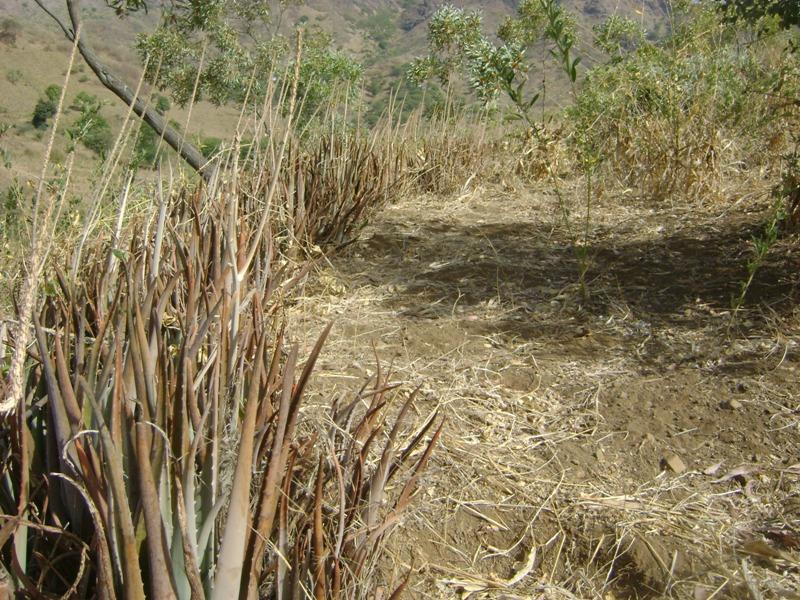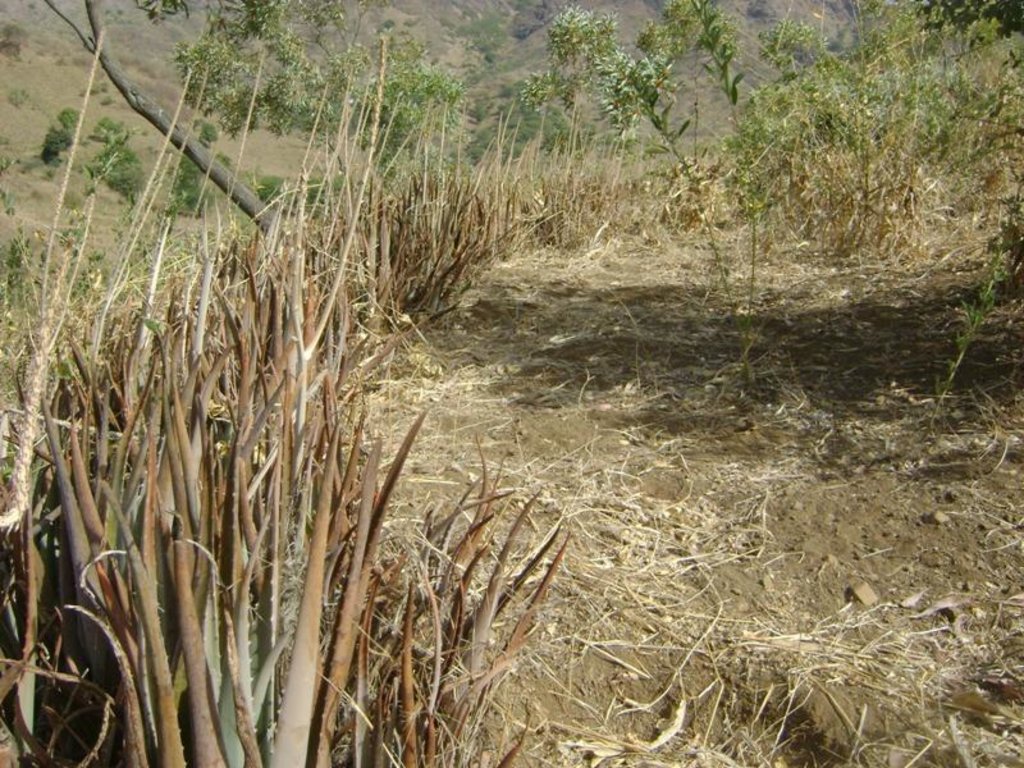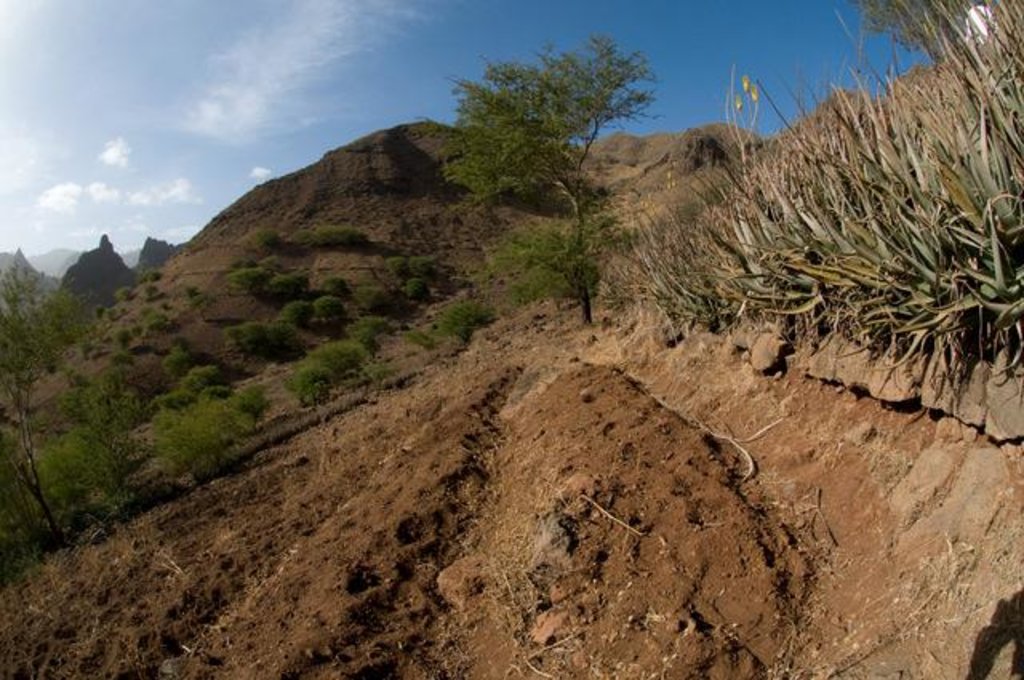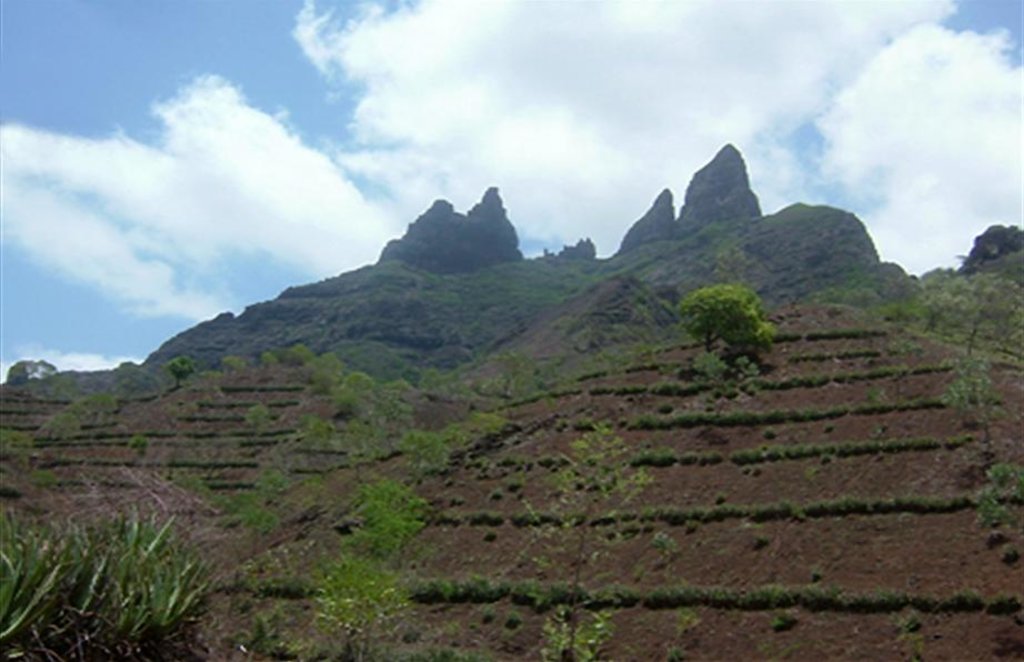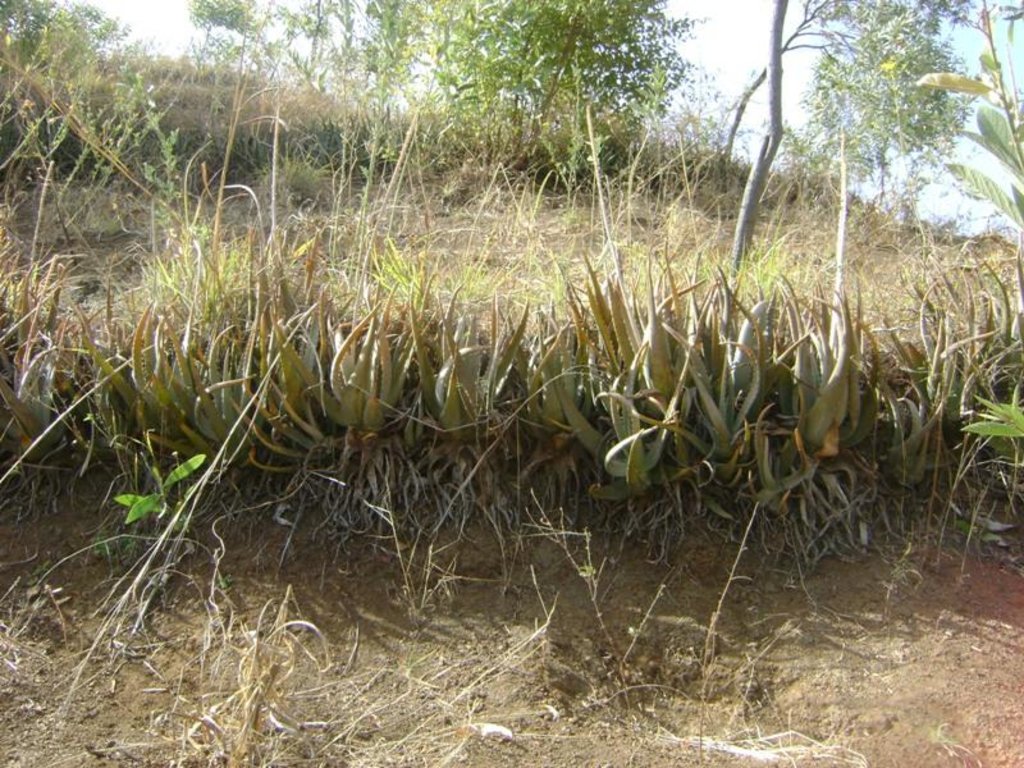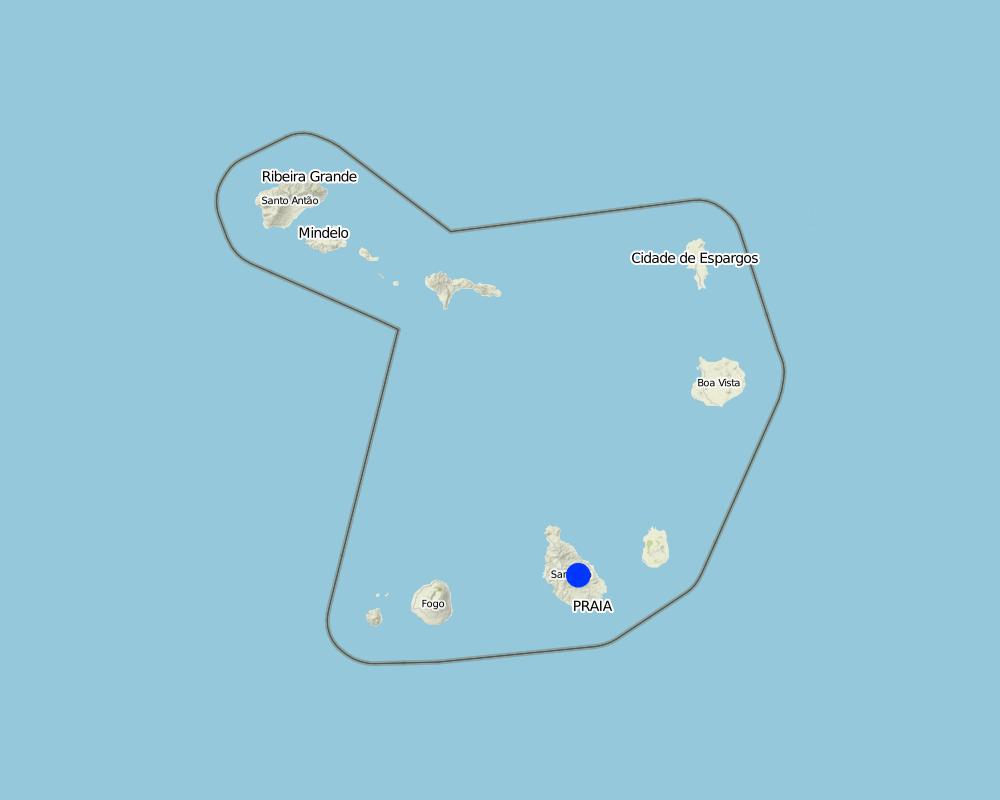Aloe Vera Living Barriers [Cape Verde]
- Creation:
- Update:
- Compiler: Jacques Tavares
- Editor: –
- Reviewer: David Streiff
Barreiras Vivas de Aloevera (Portuguese)
technologies_1334 - Cape Verde
View sections
Expand all Collapse all1. General information
1.2 Contact details of resource persons and institutions involved in the assessment and documentation of the Technology
SLM specialist:
Varela Larissa
INIDA
Cape Verde
SLM specialist:
Bentub Jailson
INIDA
Cape Verde
Name of the institution(s) which facilitated the documentation/ evaluation of the Technology (if relevant)
INIDA (INIDA) - Cape Verde1.3 Conditions regarding the use of data documented through WOCAT
When were the data compiled (in the field)?
05/03/2009
The compiler and key resource person(s) accept the conditions regarding the use of data documented through WOCAT:
Yes
2. Description of the SLM Technology
2.1 Short description of the Technology
Definition of the Technology:
It is a technique which uses the structure of a cross-slope barrier of Aloe vera to combat soil erosion by decreasing surface wash and increasing infiltration.
2.2 Detailed description of the Technology
Description:
Aloe vera is a durable herbaceous plant which is planted in the form of living barriers to recover degraded slopes on the Cape Verde Islands.
Purpose of the Technology: The plants are closely planted along the contour to build an efficient barrier for retention of eroded sediments and superficial runoff. The living hedges of Aloe vera stabilize the soil, increase soil humidity by improving infiltration and soil structure. Groundwater is recharged indirectly. Soil cover is improved, and thus evaporation and erosion reduced.
Establishment / maintenance activities and inputs: Implementation is relatively simple. The contour lines are demarcated using a water level. Seedlings are planted along one line at a distance of 30-50 cm between plants; spacing between the rows varies between 3-5 m according to the slope. The technology is applied in subhumid and semi-arid areas, on steep slopes with shallow soils, a poor vegetation cover and high soil erosion rates. These areas are generally used by poor subsistence farmers for rainfed agriculture with crops such as maize and beans, which are considered inappropriate for such slope angles. On slopes steeper than 30% the living barriers are often combined with stone walls (width 40-50 cm; height 80-90 cm). The plants stabilize the stone risers, making this combined technology one of the most efficient measures for soil erosion control on the Cape Verde Islands.
Natural / human environment: The herbaceous plant is well adapted to the local biophysical conditions and to the land use system: it can be grown with any crop, is available for any farmer, establishment and transport are simple, its green leaves are not palatable for livestock, the plant is extremely resistant to water stress and grows on any bioclimatic zone on the island. Furthermore, Aloe is known for its multiple uses in traditional medicine.
2.3 Photos of the Technology
2.5 Country/ region/ locations where the Technology has been applied and which are covered by this assessment
Country:
Cape Verde
Region/ State/ Province:
Ribeira Seca catchment
Further specification of location:
Santiago Island, Cape Verde
Map
×2.6 Date of implementation
If precise year is not known, indicate approximate date:
- 10-50 years ago
2.7 Introduction of the Technology
Specify how the Technology was introduced:
- through projects/ external interventions
3. Classification of the SLM Technology
3.1 Main purpose(s) of the Technology
- reduce, prevent, restore land degradation
3.2 Current land use type(s) where the Technology is applied

Cropland
- Annual cropping
Main crops (cash and food crops):
major food crop: Maize and beans

Grazing land
Extensive grazing land:
- Semi-nomadism/ pastoralism
- Ranching
Intensive grazing/ fodder production:
- Cut-and-carry/ zero grazing
Main animal species and products:
Goats and cattle
Comments:
Major land use problems (compiler’s opinion): Low productive land, shallow soil depth, loss of soil by runoff water, reducing its thickness and fertility
Major land use problems (land users’ perception): Low productive land, weak and thin
Semi-nomadism / pastoralism: Especially for goats
Cut-and-carry/ zero grazing: Feeding of cattle
Livestock is grazing on crop residues
3.3 Further information about land use
Water supply for the land on which the Technology is applied:
- rainfed
Number of growing seasons per year:
- 1
Specify:
Longest growing period in days: 90; Longest growing period from month to month: August to October
3.4 SLM group to which the Technology belongs
- cross-slope measure
3.5 Spread of the Technology
Specify the spread of the Technology:
- applied at specific points/ concentrated on a small area
Comments:
Total area covered by the SLM Technology is 71.5 km2.
3.6 SLM measures comprising the Technology

vegetative measures
- V2: Grasses and perennial herbaceous plants
Comments:
Type of vegetative measures: aligned: -contour
3.7 Main types of land degradation addressed by the Technology

soil erosion by water
- Wt: loss of topsoil/ surface erosion
- Wg: gully erosion/ gullying

biological degradation
- Bc: reduction of vegetation cover

water degradation
- Ha: aridification
- Hs: change in quantity of surface water
Comments:
Secondary types of degradation addressed: Bc: reduction of vegetation cover, Ha: aridification, Hs: change in quantity of surface water
Main causes of degradation: soil management (cultivation of maize in much sloping land), overgrazing, droughts (Cyclical droughts), other natural causes (avalanches, volcanic eruptions, mud flows, highly susceptible natural resources, extreme topography, etc.) specify (Steep slopes: Low vegetation cover accelerates the runoff), poverty / wealth (Level of poverty in rural areas), education, access to knowledge and support services (High illiteracy rate in rural areas (27.9%))
Secondary causes of degradation: disturbance of water cycle (infiltration / runoff) (Low vegetation is not conducive to infiltration), land tenure
3.8 Prevention, reduction, or restoration of land degradation
Specify the goal of the Technology with regard to land degradation:
- restore/ rehabilitate severely degraded land
Comments:
Secondary goals: prevention of land degradation, mitigation / reduction of land degradation
4. Technical specifications, implementation activities, inputs, and costs
4.1 Technical drawing of the Technology
Author:
Jacques Tavares
4.2 Technical specifications/ explanations of technical drawing
Aloe Vera Living Barriers on slope of more than 60%. The soil accumulated behind the barrier can reach depths of 55 cm.
Date: 15.3.10
Technical knowledge required for field staff / advisors: moderate
Technical knowledge required for land users: moderate
Main technical functions: reduction of slope length, improvement of ground cover, improvement of topsoil structure (compaction), stabilisation of soil (eg by tree roots against land slides), increase of groundwater level / recharge of groundwater, sediment retention / trapping, sediment harvesting, increase of biomass (quantity)
Secondary technical functions: control of raindrop splash, reduction of slope angle, increase of surface roughness, increase in organic matter
Aligned: -contour
Vegetative material: O : other
Number of plants per (ha): 5000
Vertical interval between rows / strips / blocks (m): 2 (m)
Spacing between rows / strips / blocks (m): 5 (m)
Vertical interval within rows / strips / blocks (m): 0.4(m)
Grass species: Aloe vera plants
Slope (which determines the spacing indicated above): 60.00%
If the original slope has changed as a result of the Technology, the slope today is (see figure below): 50.00%
Gradient along the rows / strips: 0.00%
4.3 General information regarding the calculation of inputs and costs
Specify currency used for cost calculations:
- US Dollars
Indicate average wage cost of hired labour per day:
3.30
4.4 Establishment activities
| Activity | Type of measure | Timing | |
|---|---|---|---|
| 1. | Demarcation of contour lines, using water levels | Vegetative | Early June |
| 2. | Collection of Aloe Vera plants (Aloe vera grows naturally on upper slopes and in depressions) | Vegetative | June |
| 3. | Planting | Vegetative | End of June |
| 4. | Dès la 2ème année, les espaces entre les plants d’Aloe vera se bouchent naturellement par leur propre croissance |
4.5 Costs and inputs needed for establishment
| Specify input | Unit | Quantity | Costs per Unit | Total costs per input | % of costs borne by land users | |
|---|---|---|---|---|---|---|
| Labour | Demarcation of contour lines, | persons/day/ha | 15.0 | 3.3333 | 50.0 | |
| Labour | Planting | persons/day/ha | 50.0 | 3.333333 | 166.67 | |
| Equipment | Tools | ha | 1.0 | 13.0 | 13.0 | |
| Plant material | Plants | pieces | 5000.0 | |||
| Total costs for establishment of the Technology | 229.67 | |||||
Comments:
Duration of establishment phase: 1 month(s)
4.6 Maintenance/ recurrent activities
| Activity | Type of measure | Timing/ frequency | |
|---|---|---|---|
| 1. | Vegetative control: removal of Aloe vera plants that are invading cropland (maize, peas) between the life barriers | Vegetative | annually |
| 2. | Replanting of Aloe vera to fill gaps in life barriers (very rare, survival rate is over 95%) | Vegetative |
4.7 Costs and inputs needed for maintenance/ recurrent activities (per year)
| Specify input | Unit | Quantity | Costs per Unit | Total costs per input | % of costs borne by land users | |
|---|---|---|---|---|---|---|
| Labour | Vegetative control | persons/day/ha | 10.0 | 3.3 | 33.0 | 100.0 |
| Total costs for maintenance of the Technology | 33.0 | |||||
Comments:
Machinery/ tools: levels, hoes, shovels
Labour inputs for implementation are rewarded by project: individuals of poor communities receive a salary of 3.3 US$ per day. Plants are collected locally; their value on the market would be around 3-4 US$ per plant. Establishment costs do not include labour-intensive construction of stone risers (supportive measure). Maintenance costs are borne by land users.
4.8 Most important factors affecting the costs
Describe the most determinate factors affecting the costs:
The labour used in this technique consists of individuals from poor or very poor rural communities who come to work in search of an income with a payment of 250 Escudos per day.
5. Natural and human environment
5.1 Climate
Annual rainfall
- < 250 mm
- 251-500 mm
- 501-750 mm
- 751-1,000 mm
- 1,001-1,500 mm
- 1,501-2,000 mm
- 2,001-3,000 mm
- 3,001-4,000 mm
- > 4,000 mm
Specifications/ comments on rainfall:
Rainfall areas of wet weather> 800 mm
Agro-climatic zone
- humid
- sub-humid
- semi-arid
- arid
Thermal climate class: tropics. average annual temperature of 23 ° C
5.2 Topography
Slopes on average:
- flat (0-2%)
- gentle (3-5%)
- moderate (6-10%)
- rolling (11-15%)
- hilly (16-30%)
- steep (31-60%)
- very steep (>60%)
Landforms:
- plateau/plains
- ridges
- mountain slopes
- hill slopes
- footslopes
- valley floors
Altitudinal zone:
- 0-100 m a.s.l.
- 101-500 m a.s.l.
- 501-1,000 m a.s.l.
- 1,001-1,500 m a.s.l.
- 1,501-2,000 m a.s.l.
- 2,001-2,500 m a.s.l.
- 2,501-3,000 m a.s.l.
- 3,001-4,000 m a.s.l.
- > 4,000 m a.s.l.
Comments and further specifications on topography:
Slopes on average: The slope characteristic of most of the area is steep
Altitudinal zone: 500-1000 m a.s.l. occupies the largest area.
5.3 Soils
Soil depth on average:
- very shallow (0-20 cm)
- shallow (21-50 cm)
- moderately deep (51-80 cm)
- deep (81-120 cm)
- very deep (> 120 cm)
Soil texture (topsoil):
- coarse/ light (sandy)
- medium (loamy, silty)
Topsoil organic matter:
- medium (1-3%)
- low (<1%)
If available, attach full soil description or specify the available information, e.g. soil type, soil PH/ acidity, Cation Exchange Capacity, nitrogen, salinity etc.
Soil depth on average: The depth varies with altitude, being higher in low altitudes.
Soil fertility is medium
Soil drainage / infiltration is medium
Soil water storage capacity is low but high on barriers
5.4 Water availability and quality
Ground water table:
5-50 m
Availability of surface water:
poor/ none
Water quality (untreated):
poor drinking water (treatment required)
Comments and further specifications on water quality and quantity:
Water quality (untreated): Much of the groundwater is saline due to over-exploitation of aquifers. But can also be good
5.5 Biodiversity
Species diversity:
- low
Comments and further specifications on biodiversity:
Most species are cultivated and others are introduced
5.6 Characteristics of land users applying the Technology
Market orientation of production system:
- subsistence (self-supply)
- mixed (subsistence/ commercial
Relative level of wealth:
- average
- rich
Individuals or groups:
- individual/ household
Level of mechanization:
- manual work
- mechanized/ motorized
Indicate other relevant characteristics of the land users:
Land users applying the Technology are mainly Leaders / privileged
Population density: 100-200 persons/km2
Annual population growth: > 4%; 5%
1% of the land users are rich (0.5).
and own 3% of the land (1).
80% of the land users are poor (50).
Market orientation of production system: Subsistence mainly for rainfed crops.
5.7 Average area of land owned or leased by land users applying the Technology
- < 0.5 ha
- 0.5-1 ha
- 1-2 ha
- 2-5 ha
- 5-15 ha
- 15-50 ha
- 50-100 ha
- 100-500 ha
- 500-1,000 ha
- 1,000-10,000 ha
- > 10,000 ha
Is this considered small-, medium- or large-scale (referring to local context)?
- medium-scale
Comments:
Also < 0.5 ha (for grasslands, which is secondary to production of cereals), 0.5-1 (very poor) ha, 1-2 ha (poor) 2-5 ha (rich)
5.8 Land ownership, land use rights, and water use rights
Land ownership:
- individual, titled
- Diocese
Land use rights:
- leased
- individual
- hereditary
Water use rights:
- communal (organized)
- hereditary
5.9 Access to services and infrastructure
health:
- poor
- moderate
- good
education:
- poor
- moderate
- good
technical assistance:
- poor
- moderate
- good
employment (e.g. off-farm):
- poor
- moderate
- good
markets:
- poor
- moderate
- good
energy:
- poor
- moderate
- good
roads and transport:
- poor
- moderate
- good
drinking water and sanitation:
- poor
- moderate
- good
financial services:
- poor
- moderate
- good
6. Impacts and concluding statements
6.1 On-site impacts the Technology has shown
Socio-economic impacts
Production
crop production
fodder production
fodder quality
animal production
wood production
risk of production failure
production area
Comments/ specify:
About 8% if the production area is 1 ha
Water availability and quality
drinking water availability
demand for irrigation water
Socio-cultural impacts
food security/ self-sufficiency
cultural opportunities
Comments/ specify:
Aloe Vera is used in traditional medicine / personal hygiene: pills against anaemia, diabetes and digestion problems; bactericide for wound treatment
SLM/ land degradation knowledge
conflict mitigation
livelihood and human well-being
Comments/ specify:
Aloe Vera is used in traditional medicine, and is also used in personal hygiene.
Ecological impacts
Water cycle/ runoff
water quantity
water quality
harvesting/ collection of water
surface runoff
excess water drainage
evaporation
Soil
soil moisture
soil cover
soil organic matter/ below ground C
Biodiversity: vegetation, animals
biomass/ above ground C
plant diversity
animal diversity
6.3 Exposure and sensitivity of the Technology to gradual climate change and climate-related extremes/ disasters (as perceived by land users)
Gradual climate change
Gradual climate change
| Season | Type of climatic change/ extreme | How does the Technology cope with it? | |
|---|---|---|---|
| annual temperature | increase | well |
Climate-related extremes (disasters)
Meteorological disasters
| How does the Technology cope with it? | |
|---|---|
| local rainstorm | well |
| local windstorm | well |
Climatological disasters
| How does the Technology cope with it? | |
|---|---|
| drought | not well |
Hydrological disasters
| How does the Technology cope with it? | |
|---|---|
| general (river) flood | well |
Other climate-related consequences
Other climate-related consequences
| How does the Technology cope with it? | |
|---|---|
| reduced growing period | well |
Comments:
Aloe vera it is resistant to lack of water because of their physiognomy and anatomy, but can not resist a big drougth
6.4 Cost-benefit analysis
How do the benefits compare with the establishment costs (from land users’ perspective)?
Short-term returns:
slightly negative
Long-term returns:
very positive
How do the benefits compare with the maintenance/ recurrent costs (from land users' perspective)?
Short-term returns:
neutral/ balanced
Long-term returns:
very positive
Comments:
The structure does not require costly maintenance, it is simply controlling the spacing of the barrier (vegetative control) and punctual replanting.
6.5 Adoption of the Technology
- 1-10%
If available, quantify (no. of households and/ or area covered):
400 households covering 10 percent of the stated area.
Of all those who have adopted the Technology, how many have did so spontaneously, i.e. without receiving any material incentives/ payments?
- 0-10%
Comments:
20 land user families have adopted the Technology without any external material support
There is a little trend towards spontaneous adoption of the Technology
6.7 Strengths/ advantages/ opportunities of the Technology
| Strengths/ advantages/ opportunities in the land user’s view |
|---|
|
Improves the thickness of the soil leaving it stronger and more productive How can they be sustained / enhanced? The mineral and organic matter retained behind the lines of Aloe vera will promote an increase in the thickness of the soil, improving also the volume of water retained in the soil, resulting in better root development. Therefore, the process of soil formation is best done. |
| Strengths/ advantages/ opportunities in the compiler’s or other key resource person’s view |
|---|
|
Recover the degraded land and increase the production How can they be sustained / enhanced? The vegetation of the area between the barriers will make the recovery and protection of the soil layer is stronger |
|
Stabilizes the soil making it more resistant to the impact of the rain water How can they be sustained / enhanced? Sedimentation behind the barriers is favored along the time due to the continued growth of the plant Aloe vera |
6.8 Weaknesses/ disadvantages/ risks of the Technology and ways of overcoming them
| Weaknesses/ disadvantages/ risks in the compiler’s or other key resource person’s view | How can they be overcome? |
|---|---|
| Reduction of the production area, which is occupied by bands of Aloe vera | Annual vegetative control within cultivated area and by cutting Aloe vera plants growing outside the living barriers, using it more economically |
7. References and links
7.2 References to available publications
Title, author, year, ISBN:
DESIRE-project. 2010.
Available from where? Costs?
http://www.desire-project.eu/
7.3 Links to relevant information which is available online
Title/ description:
DESIRE-project. 2010.
URL:
http://www.desire-project.eu/
Links and modules
Expand all Collapse allLinks
No links
Modules
No modules


